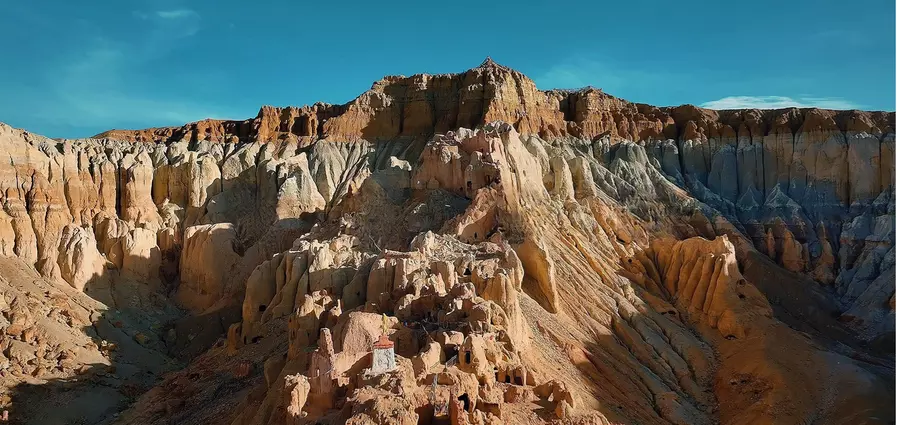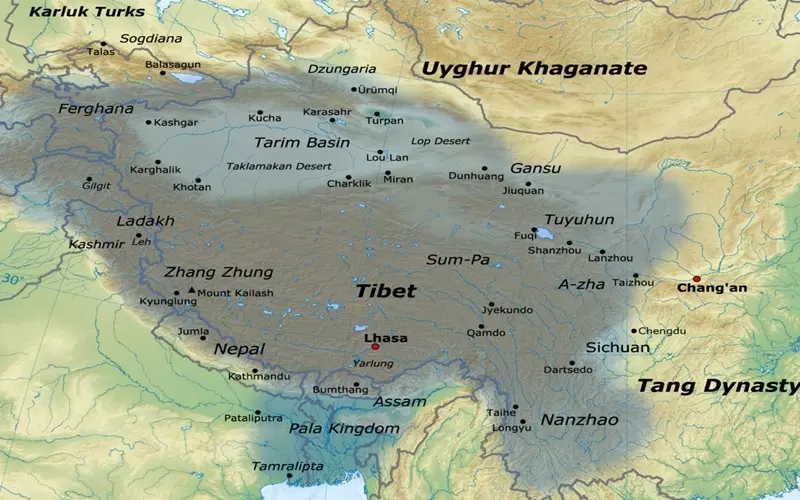Zhangzhung: The Ancient Tibetan Kingdom and Culture
- by Catherine
- Last Updated: 2025-04-02

Zhangzhung (also Shangshung or Xiangxiong), is written according to the transliteration of the Tibetan word ཞང་ཞུང་. It is the kingdom and ancient culture of western and northwestern Tibet. It was founded in the Iron Age between 1500 BC and the first year of the AD and perished in the Tubo Dynasty in 645. Zhangzhung Empire was a tribal state that dominated the ancient Tibetan plateau before the Tubo kingdom. The capital city, Kyunglong, is located on the edge of Lake Tangra Yumcoin, in today’s Ngari region. The ancient Zhangzhung Kingdom created extremely high civilizations. It formed not only its own unique Zhangzhung characters but also the birthplace of the Yungdrung Bon religion. Yungdrung Bon culture is actually equivalent to Zhangzhung culture. Zhangzhung culture predates the Tibetan Buddhist culture in Tibet and is the source of all Tibetan culture.
Territory of The Zhangzhung Kingdom
According to the traditional saying in Bon literature, Zhangzhung consists of three parts, namely: Zhangzhung Phug-pa(the inner), Zhangzhung Bar-ba(the middle), and Zhangzhung sGob-ba(the outer). Zhangzhung Phug-pa is three months away from the west of Mounts Gangdise, in the areas of Persian, Bactria, and Bara. It is speculated that these places probably refer to Kashmir and its western area bordering India and Pakistan. Zhangzhung Bar-ba is centered on Kyunglong, which is the capital city of the Zhangzhung kingdom. It is in the south of Gangdise Mountains, the hinterland of today's Ngari area. Bar-ba is characterized by caves, where many of Bon's masters ever practiced. sGob-ba's geographical scope is even broader, which includes the area around Dingqing in Tibet and Yushu in Qinghai today. In terms of the current geographical concept, the area covered by Zhangzhung starts from the western part of Pakistan-controlled Kashmir (Gilgit) and borders Congling, and Hetian of Xinjiang in the north, including the entire Qiangtang uninhabited area. To the south, it covers India-controlled Kashmir and a part of Nepal and extends to Qamdo and Yushu in the east. In other words, Zhangzhung's territory includes not only 1.22 million square kilometers of the Tibet autonomous region, but even more. However, in Tibetan Buddhist literature, the Yarlung Zangbo River Valley (Lhasa and Shannan), located in the core area of Tibet, is not within the scope of Zhangzhung.
Culture and Religion of Zhangzhung
Zhangzhung culture is the traditional culture of the Tibetan people and is also known as the foundation culture of Tibet. The traces of ancient Zhangzhung culture run through all aspects of Tibet, from industries to lives and from folk customs to beliefs. Religious activities such as offering sacrifices to mountain gods and holy mountains kora all originated from Zhangzhung culture. Tibetan script originated from the Zhangzhung script. Ancient Zhangzhung Buddha dharma is the oldest native Buddha dharma in Tibet and the essence of Zhangzhung culture. The prince of Zhangzhung, Shenrap Miwo, in order to save sentient beings, compassionately preached Yungdrung Bon. The Buddha's koan is represented with 卍, which is called "Yungdrung" in Tibetan. "Yung" is a symbol of harmony and eternity, which is the true meaning of the Buddha drama. "Drung" means carnal deathlessness. Long before Indian Buddhism was introduced into Tibet, the ancient Zhangzhung Buddha dharma-Yungdrung Bon religion had been widely spread in the snowy plateau, and it was the most important spiritual belief of the Tibetan people. “Great Perfection” is not only the core of the ancient Buddhist dharma but also the essence of all spiritual civilization and traditional culture in Tibet. It is also the wisdom and essence of civilization accumulated by the people who live on the mysterious land of the Qinghai-Tibet plateau.
The Influence of Zhangzhung Culture
Both ancient Zhangzhung cultures and religions have had a great influence on later generations. The well-known Mt.Kailash kora, worshiping the holy lake, kowtow, scattering Longda, hanging prayer flags, dispelling evil spirits with fire and smoke, Mani stones, Torma, Butter sculpture, Vajra knot, as well as Tibetan language, Tibetan Guozhuang dance, Thangka paintings, etc. are derived from the ancient Zhangzhung culture. The ancient Zhangzhung culture even influenced the cultures of many other surrounding countries and nations.
Conclusion
The Zhangzhung Kingdom's legacy remains deeply woven into Tibetan culture, religion, and traditions. Though the kingdom vanished with the rise of the Tubo Dynasty, its influence endures in the Yungdrung Bon religion, Tibetan script, and sacred rituals. Many cultural practices, from kora to prayer flags, trace back to Zhangzhung. Preserving this heritage helps us understand Tibet’s roots and its lasting impact on the region.
Related Articles
- Khyung Lung Dngul Mkhar
- Bhutan Nepal Tibet Tour
- Lanzhou and Tibet Tours
- Nagqu Travel Guide
- Tibetan Guide
- Tibet Cultural Tours
- Most Famous Tibetan Monasteries and Temples
- How to Travel from Nepal to Tibet?
- Shigatse Travel Guide
- Lhoka Travel Guide
Email response within 0.5~24 hours.




Typically Asked Questions from Our Clients
Asked by Alon***
Would Bon be described as patriarchal or matriarchal, or both in equal measure?
Can you provide examples?
Thank you
Dear Alon****,
Benzeneism has cosmic oogenesis theory: the universe is the beginning of the "void". The void gave birth to two originals, one for the light, and one for the darkness. The oogenesis theory actually reflects a maternal conception of the origin of the universe.